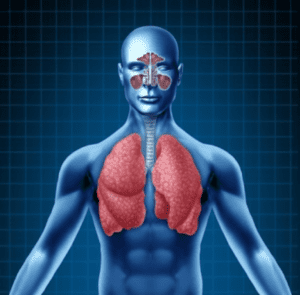Asthma is the body’s reactions to many kinds of irritants. During a bronchial asthma attack, the bronchii do not allow sufficient air to reach the lungs and the individual begins to labor for breathe. Often the person will feel tightness in the chest and may gasp for air. The face may turn pale or gray or become blue around the lips. It’s common for those experiencing an acute flare-up to cough or spit up a considerable amount of mucus. For many people, asthma attacks become more chronic over many years. The most common asthma is bronchial asthma, which is caused by a narrowing of the breathing passages that carry air from the throat to the lungs. This narrowing is created by muscle spasming, local respiratory inflammation or the production of excess mucus. Any or a combination of all three symptoms will lead to difficulty with shortness of breath accompanied by wheezing. This complex process is known in the medical world as the inflammatory cascade. Studies have revealed that lung inflammation persists even after asthma symptoms have gone.
A couple of decades ago, asthma attacks were thought to be brought on by constricted airways in the lungs, which in turn made it difficult to breathe. At the time, asthma was thought to be easily treated. This lead to the use and eventual overuse of certain medications, such as bronchialdilators and adrenaline like drugs that targeted constricted air passages. Then researchers discovered that asthma is characterized not only by constricted airways but by excess mucus production and inflammation of the tissues of the lungs and bronchial passageways. Added to this mix, is one often overlooked aspect asthma: muscle fatigue. After days or even weeks of laboring to breathe in enough air, a deep muscle fatigue can set in around the shoulders and neck, making breathing during an asthma attack even more difficult. There are many interrelations of these factors that make asthma more complex.
A Healthy Respiratory System
When a healthy person inhales, he/she enlists the diaphragm, a powerful muscle that sits underneath the lungs, to draw in air. The air is filtered and humidified though the nose or mouth then passes down the windpipe into the bronchi tubes, which then lead into bronchioles or smaller tubes that travel into the lung tissues. The bronchioles, in turn deliver the air to millions of tiny sacs called alveoli, which reside deep in the lungs. The alveoli passively expand and contract as oxygen is delivered to the blood stream and carbon dioxide is sent back to the lungs to be exhaled. In a healthy person, it is a perfectly regulated process, efficient no matter whether one is running, eating or sleeping.
This process goes awry in asthmatics. When a child or adult tries to breathe during an attack, their respiratory function is compromised. First the airways constrict. Next, a powerful inflammatory reaction may occur, which activates inflammatory cells such as mast cells and macrophages. As tissues in and around the lungs become irritated and inflammed, the muscles surrounding the bronchi tighten up. Once the respiratory tissues are irritated and swollen, they are easily infected by bacteria or viruses or they become reactive to pollens, dust, animal dander, mold or environmental chemicals. Goblet cells then secrete mucus, which can clog airways and further irritate the already raw and inflammed tissues. The end result is the common symptoms of an asthma attack.
Doctors & naturopaths categorize asthma into the following forms: 1) Allergic asthma which is asthma caused by allergens inhalants that are breathed into the lungs This can include a wide range of inhalant allergens from dust & dust mites, pollens, grasses, animal dander, molds. Other irritants can be environmental chemicals such as smoke, diesel fuels, 2) Non allergic asthma, often triggered by chronic infections (both viral, yeast or bacteria) 3) Asthma resulting from emotional or physical situations (such as exercise) an often overlooked cause of asthma not recognized by much of the medical community is asthma as a reaction to foods, either allergic or intolerance. More evidence for this type of trigger is mounting. Stay tune for my next blog on food sensitivities being one of the hidden causes & triggers for chronic inflammatory lung conditions.







